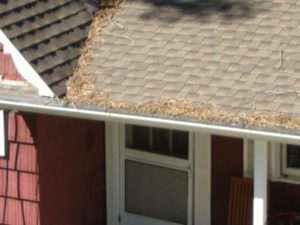The Most Important Step to Protecting the Home
A major 2014 study by fire ecologists from UCSB and around the world concluded:
To mitigate the risk of structure losses during wildfires, there is increasing evidence from many regions that it is best to focus on the house first and move outward from there. Most structure losses are due to ember attack, when flaming or smoldering plant material is lofted by winds and blown inside or against the building or adjacent elements, often long before the flaming front arrives.
While not typically the focus of wildfire mitigation efforts, scientists have known that retrofitting or constructing homes with fire-safe materials is vitally important to reducing the risk of home ignition. Embers (also known as firebrands) can cause home ignition by entering gaps as small as two millimeters or by accumulating against flammable building features such as wood siding or roof shingles.
Fire Safe Building Materials
It is important to build or retrofit a home with fire-safe materials — especially in and around the wildland-urban interface. While fire-safe construction does not ensure that a home does not ignite, it can greatly increase the chances of home survival during a wildfire.

Noncombustible fiberglass asphalt shingles. Photo courtesy Center for Fire Research and Outreach, UC Berkeley.
Roofing
When it comes to wildfire, one of the most important features of the home is the roof. Fiberglass-asphalt shingles, clay tiles, or metal sheets are the primary alternatives to flammable wood shingles. If a home’s roof is made of untreated wood shingles, a homeowner’s number one priority should be replacing it with fire-safe roofing material. A roof’s edge can also be an entry point for embers. It is important to use fire-safe materials here as well. Roof edges are where gutters are located, which can be ignition points. It is important to keep gutters clear of flammable debris such as pine needles. A simple gutter cover can be used to screen plant material while still maintaining the gutter’s functionality.
Vents and Eaves
All vents should have screens designed to keep out embers. Eaves are another important feature that must be considered when fire-proofing a home. Narrower eaves will provide better protection against embers. Soffits, or the undersides of overhanging eaves, should be protected with a fire-resistant covering.
Windows
Windows can serve as entry points for embers when the wrong material or design is used. Single pane windows can also allow heat intrusion that can ignite flammable materials inside the home such as curtains. Always use double-paned, tempered glass windows to ensure that pressure differences caused by heat on the outside of the home will not shatter the window and allow ember entry. If it is a sliding window, the separator should be reinforced so that it does not deform when heated and allow embers to penetrate the resulting gap.
Material Ratings
Homeowners should choose siding materials that are the least likely to combust, such as fiber cement. The same goes for any outside trim. A rule of thumb should be that adjacent home features should have the same rating of combustibility. Products that are rated as “noncombustible” are ideal, and they should be used whenever possible.
A great example of a home built with fire-safe materials comes from Ojai, near the Los Padres National Forest. This home survived the 2017 Thomas Fire that destroyed several homes in the same area. See the short documentary about this well-designed home below.
There are many other aspects of fire safe building materials that can be important for homeowners. The Center for Fire Research and Outreach at UC Berkeley has created a useful tool for exploring fire-safe building materials and techniques, which can be found here.
Eliminate Flammable Materials Near the Home
Care must be taken to remove potential ignition sources from around the outside of the home. Embers can easily ignite leaf piles, patio furniture, and wood piles. If this happens close to the home or on a roof, the resulting fire can cause features in the home to ignite. Keeping flames away from the sides or roof of a home is important to reduce the risk of home ignition. Establishing and maintaining smart defensible space is also important to protect against an advancing wildfire.
Debris accumulation can especially occur on roofs and in gutters. These must be periodically cleared to reduce the risk of ignition during a nearby wildfire.
Other Steps to Help Protect Homes from Wildfire
There are also simple steps that can be taken around the home to help defend against ember intrusion. Watch Dr. Jack Cohen with the Forest Service’s Missoula Fire Sciences Lab explain how your home can survive a wildfire:







